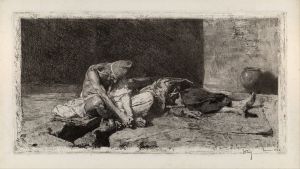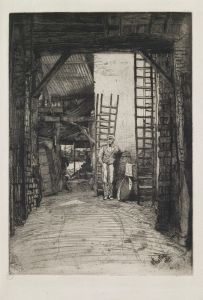
Temple
A hand-painted replica of James Abbott McNeill Whistler’s masterpiece Temple, meticulously crafted by professional artists to capture the true essence of the original. Each piece is created with museum-quality canvas and rare mineral pigments, carefully painted by experienced artists with delicate brushstrokes and rich, layered colors to perfectly recreate the texture of the original artwork. Unlike machine-printed reproductions, this hand-painted version brings the painting to life, infused with the artist’s emotions and skill in every stroke. Whether for personal collection or home decoration, it instantly elevates the artistic atmosphere of any space.
James Abbott McNeill Whistler was an American artist known for his significant contributions to the art world during the late 19th century. He was a proponent of the Aesthetic Movement, which emphasized the visual and sensual qualities of art and design over more narrative or moralistic themes. Whistler's work often focused on the harmony of color and form, and he was known for his innovative approach to composition and his use of subtle tonal variations.
One of Whistler's lesser-known works is "Temple," which, like many of his pieces, reflects his interest in capturing the atmospheric effects of a scene. Whistler's style was heavily influenced by his time in Europe, particularly his exposure to the works of the French Impressionists and the Japanese art that was becoming popular in the West during his lifetime. His paintings often exhibit a delicate balance between realism and abstraction, characterized by a muted color palette and an emphasis on mood and atmosphere.
"Temple" is an example of Whistler's ability to convey a sense of place and mood through his unique artistic vision. While specific details about the painting "Temple" are not widely documented, it can be inferred that the work aligns with Whistler's broader artistic themes. His paintings often feature architectural elements, landscapes, or urban scenes, rendered with a focus on the interplay of light and shadow.
Whistler's approach to art was revolutionary for his time. He often titled his works using musical terms, such as "nocturne," "symphony," or "arrangement," to emphasize the importance of composition and tonal harmony. This approach was part of his broader philosophy that art should be appreciated for its beauty and form, rather than its subject matter or narrative content.
Throughout his career, Whistler was known for his meticulous attention to detail and his commitment to his artistic vision. He was a controversial figure in the art world, often clashing with critics and other artists over his unconventional ideas. Despite this, his work has had a lasting impact on the development of modern art, influencing generations of artists who followed.
Whistler's legacy is evident in his ability to capture the essence of a scene with minimalistic yet evocative techniques. His work continues to be celebrated for its beauty and innovation, and his influence can be seen in various art movements that emerged after his time. While "Temple" may not be as widely recognized as some of his other works, it remains a testament to Whistler's skill and his unique approach to art.
In summary, James Abbott McNeill Whistler's "Temple" exemplifies his mastery of mood and atmosphere, reflecting his broader artistic philosophy and his significant contributions to the art world. His work remains influential, celebrated for its aesthetic beauty and its role in shaping the direction of modern art.






![Approach to the Temple of Wady Sabua [Wadi al-Sabua], Nubia.](/imgs/217463/s/david-roberts-approach-to-the-temple-of-wady-sabua-wadi-alsabua-nubia-41e9aa7e.jpg)
![Temple of Isis on the roof of the great temple of Dendera [Dandara].](/imgs/217547/s/david-roberts-temple-of-isis-on-the-roof-of-the-great-temple-of-dendera-dandara-fd95528e.jpg)










